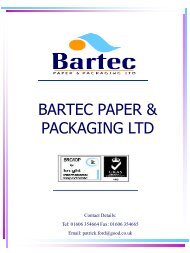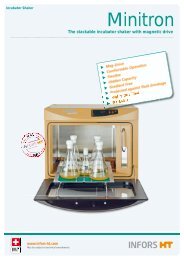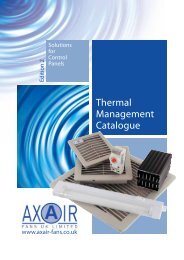Fastening & Assembly Solutions & Technology July 2012
Fastening & Assembly Solutions & Technology July 2012
Fastening & Assembly Solutions & Technology July 2012
You also want an ePaper? Increase the reach of your titles
YUMPU automatically turns print PDFs into web optimized ePapers that Google loves.
Innovative cleanliness<br />
compliance concept<br />
The VDA 19 guideline and the ISO<br />
16232 standard define new requirements<br />
for the automobile industry for verifying<br />
technical cleanliness. The<br />
Cleancon cleanliness concept developed<br />
by Arnold Umformtechnik goes a step<br />
further and provides a process that<br />
encompasses cleanliness requirements all<br />
the way from production to the customer<br />
application.<br />
All OEMs currently rank electronics<br />
failures as the top cause of vehicle problems.<br />
Consequently, the technical cleanliness<br />
of not only electronic components,<br />
but also pneumatic and hydraulic components,<br />
used in brakes, engines and chassis,<br />
is increasingly a matter of concern for the<br />
automobile industry. With the ongoing<br />
trend of increased performance and<br />
reduced size of units and modules, microscopic<br />
particles on component surfaces<br />
can easily cause malfunctions.<br />
Arnold Umformtechnik says it has<br />
come up with a suitable solution in the<br />
form of its Cleancon cleanliness concept,<br />
which consists of five steps. First limits<br />
are defined In the customer requirements<br />
profile, the environment is analysed, surface<br />
and inspection specifications are<br />
recorded, and the packaging is specified.<br />
Then during production, the entire process<br />
is accompanied by cleaning processes.<br />
In the cleanroom, the parts are microcleaned,<br />
anti-friction coatings are applied<br />
as necessary, and the components are<br />
packaged.<br />
In the VDA 19 compliant cleanliness<br />
analyses, an adapted extraction method is<br />
used and the particle size distribution and<br />
gravimetrics are investigated. And finally,<br />
the components are placed in Cleanpack<br />
multi-layer packaging to preserve cleanliness,<br />
with an internal layer that secures<br />
the components and an outer layer that<br />
can be printed or marked according to<br />
individual requirements.<br />
The system eliminates the need for an<br />
external specialist firm that microcleans<br />
the fasteners before they are used in<br />
assembly.<br />
The company suggests that a comparison<br />
of the Cleancon process to the conventional<br />
process leads to a clear conclu-<br />
FAST JULY <strong>2012</strong><br />
To fulfil the latest requirements of the vehicle buildingindustry, manufacturers must identify and<br />
quantify any particle contamination present in their components. FAST examines a cleanliness<br />
concept that can run right through the manufacturing cycle<br />
Using the Cleancon process dramatically<br />
reduces the number of metallic particles<br />
CLEAN MANUFACTURE<br />
sion that the number of metallic particles<br />
is reduced dramatically. This is accompanied<br />
by improved assembly security and<br />
the opportunity for further component<br />
miniaturisation, which translates into<br />
higher power density and smaller structures.<br />
A new cleanroom design provides conditions<br />
similar to those of a high-class<br />
cleanroom. This is where the fastener<br />
components come at the end of the production<br />
process for microcleaning using<br />
advanced equipment, for the application<br />
of anti-friction coatings immediately after<br />
cleaning, and for cleanliness-preserving<br />
packaging in Cleanpack containers.<br />
The latter two operations safeguard<br />
component cleanliness against the effects<br />
of external downstream process steps.<br />
The special internal layer of the<br />
Cleanpack packaging provides antistatic<br />
protection and mechanically secures the<br />
components so they cannot move relative<br />
to each other during transport, unlike bulk<br />
transport, putting an end to post-production<br />
particle contamination.<br />
ARNOLD +49 7947 821 170<br />
Round the clock CAD availability<br />
In situations where fastening components are<br />
needed, design and development departments in<br />
the automobile and electronics industries are<br />
faced with the challenge of reducing costs by<br />
using innovative fastener technologies. To<br />
achieve this goal, access to design data in electronic<br />
form is increasingly important.<br />
ArnCAD has been developed as a solution to<br />
this challenge. This engineering tool combines<br />
a portfolio of innovative fastener components<br />
for the direct assembly of metals and plastics<br />
with the advantages of an electronic design database. To ease the incorporation of<br />
fastening components into the user’s drawings and applications, CAD data in 2D<br />
and 2D form are now available online. The high-quality data can be used in every<br />
CAD system and can be included directly in the design process by means of a<br />
simple download.<br />
25











